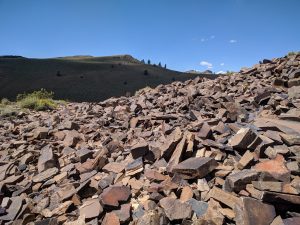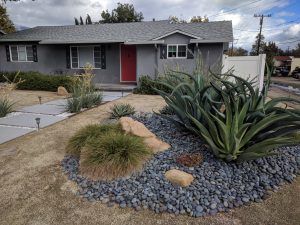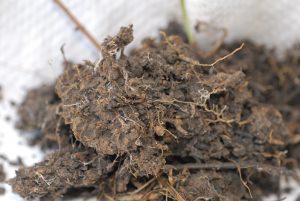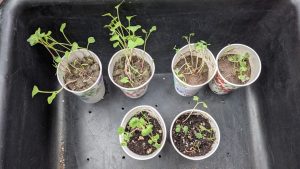My Soil is Crap! Or is it?
Over several years of teaching basic soil science to arborists, master gardeners and students something started to coalesce into a trend. If I ask my students do they have “good” soil, many say no. I have heard Master Gardeners complain their soil is terrible or that a certain soil is bad in some way. People form opinions about soil based on its color, texture, odor, or even how plants grow in it (perhaps the most diagnostic quality). So how do you know if your soil is “crap”? Soil is a combination of physical, chemical and biological properties not all of which are obvious from a casual examination. Soil is infinitely variable depending on how it was formed and what has happened to it. Many soils are fragile and their growing properties can easily be harmed.

Soil Formation
To understand soil you need to understand how it forms. Soils are often depositional, forming as particles are deposited in place from wind, or water or other weathering factors. Deep soils form from the alluvium as water washes particles down from mountains. Terraces along streams also form soil deposits when they overflow the stream bed. Almost all soils form from rocks that are referred to as the parent material. The kind of rocks that form the parent material determine the minerals that will dominate that soil. Exotic soils like serpentine soil contain large amounts of magnesium but lack calcium. Soils can be young (not deep or fine textured) or very old (deep clays). One of first things gardeners should seek to find out is if they have “native” soil or are gardening on fill. Soils are also modified by climate especially rainfall. High rainfall areas have leached soils, are usually forested, and have acid soil reaction (pH). Arid soils usually have excess salts, and tend toward being alkaline. Understanding soil formation helps to understand what kind of soil you have and how to utilize it best for your garden.

Fill is not Soil
One of first things gardeners should discover is if they have “native” soil or are gardening on fill. Fill around homes and cities is not soil in the natural sense. Fill soil is not formed in a natural process, it will not have the predictable qualities of soils and may be extremely variable even on a single property. Soil maps are available from your cooperative extension office and on line from the NRCS (https://websoilsurvey.sc.egov.usda.gov/App/HomePage.htm). The web soil survey is a map of naturally occurring soil types. Soils are described in detail and understanding your soil type will inform its ability to grow plants, hold water and minerals, etc.
Soil Physical Properties
No matter which soil you have, gardeners will want to know what to do to make it better for growing their plants. The physical characteristics of soil are important for gardeners to understand. Soil texture is described by analyzing the content of various particle sizes. Sands are composed of large particles silts have intermediate size particles and clays contain the finest particles. Soils texture is the relative content of sand, silt and clay particles and are described by their content of these particles such as a “clay loam” Pure loams are relatively rare because they have equal measures of sand silt and clay and are considered the most arable soil textures. A clay loam has more clay than the other particle sizes but enough to still be considered a loam. Textural classes are described by the soil triangle. You can diagnose your soil texture by using a ribbon test where you feel the soil and analyze its qualities. A laboratory can separate the particles and give an exact analysis. Soil texture affects horticulture directly as it determines drainage characteristics, moisture content and mineral holding capabilities.
Soil Chemical Qualities
One of the most defining chemical qualities of soil for gardeners is nutrient content. Minerals or elements in soils are highly variable based on soil age, their formation processes and the parent material from which they developed. Fine textured soils have more mineral nutrients and storage capacity than coarse textured soils. Sands tend to be hungry for plant nutrients and clays are usually rich in nutrients. This is because as particle size decreases the electrical properties of soil become more negative in charge and tend to retain positively charged mineral nutrients. You can estimate nutrient content by seeing how plants grow in a given soil without fertilization. If weeds are abundant and happy, the soil may contain adequate amounts of the 18 different elements necessary for plant growth. The only way to accurately know the nutrient content of a soil is to have it analyzed in a soils lab. There are other blogs at this site that tell you how to take a soil sample. Never fertilize a soil that already grows plants well as you will be polluting surface waters and contaminating streams with excess fertilizer elements that can leach or run off.

Biological Qualities of Soil
The most elusive quality of soil is the biological quality. Soils are ecosystems of organisms. Much has been written about the soil food web and it is a critical part of how soils and plants interact. While we can see worms and small arthropods; bacteria, fungi and nematodes are not visible. It is difficult to visually assess soil biology. However there are some indicators. “Healthy” soils are often well structured. Soil structure is a physical description of the way soils form aggregates, clumps and clods. Well structured soils have abundant pore spaces, bits of organic matter, and have distinct clods or clumps. Often these clods are water-stable, that is, if you put a soil clod in a jar of water it will not dissolve. This is an easy test you can make of your soil. Place a clod in water and leave it there over night if it dissolves it is not a water-stable aggregate. Water stable aggregates from from the action of soil microorganisms that bind soil particles with polymers as well as the hyphae of fungi which connect particles together.
Soil Carbon Drives Soil Biology
Healthy soils have more carbon in them then soils that are not biologically active. Organic matter is an important part of soil and is added as litter or mulch breaks down and by plants themselves as they deposit carbon through exudates and associations with microorganisms. Plants can add as much as 20% of their carbon captured through photosynthesis into soil through root exudates and microbial association. Carbon is food for microbes and an essential component of a healthy soil. Soil with large amounts of organic matter are dark in color (but so are many low OM clays so don’t be fooled). Again the only way to know exactly how much organic matter is in soil is by a soil test. A detailed soil organism analysis may not help you that much because it is difficult to assign specific roles to groups of organisms living in soil. If we provide organic matter (fresh wood chip mulches in perennial plantings) the food web will grow to utilize it and we do not need to worry about who is using the carbon.

Despite all these factors soils are still a bit magical. Even with soil surveys, and soil analyses you really can’t tell if a soil will grow well until you try to do so. In my University class I am having my students do a simple bio-assay (growing seeds in soils) The assignment was to grow radish and carrots in three different soils, hoping that some would show up signs of damping off disease. I did the experiment as well. My seedlings were grown in a silt loam, a clay loam and a potting medium. The soil-based differences are very visible. The clay loam grew the largest seedlings. Bio assays such as this are helpful to see what the growing qualities of soil are. They don’t tell the entire story but they are very interesting for comparative purposes. Bio assays are great to do before you purchase soil for raised beds or if you are gardening in a new soil that you don’t know much about. In the next blog I will touch on how, when, and why soils should be modified to enhance your garden.
Love the radish/carrot experiment! Didn’t know about the clod-in-water test.
Please ignore my previous comment. I did find the menu, although I never did find Part 3 on crap soil.
There isn’t a part 3. Did you see a specific reference somewhere that a part 3 was coming?
In response to yesterday’s question about greensand from Roianne Cox, Doug Grimes referred to a three-part series on soils, and linked to the first My Soil Is Crap post as part 1. That’s why I thought there were 3 posts.
Dr. Downer may or may not add a part 3…that will be up to him! Sorry for the confusion.